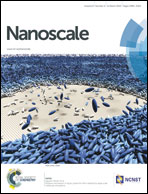Tunable photoluminescence and spectrum split from fluorinated to hydroxylated graphene†
Abstract
Tunable control over the functionalization of graphene is significantly important to manipulate its structure and optoelectronic properties. Yet the chemical inertness of this noble carbon material poses a particular challenge for its decoration without forcing reaction conditions. Here, a mild, operationally simple and controllable protocol is developed to synthesize hydroxylated graphene (HOG) from fluorinated graphene (FG). We successfully demonstrate that under designed alkali environment, fluorine atoms on graphene framework are programmably replaced by hydroxyl groups via a straightforward substitution reaction pathway. Element constituent analyses confirm that homogeneous C–O bonds are successfully grafted on graphene. Rather different from graphene oxide, the photoluminescence (PL) emission spectrum of the obtained HOG becomes split when excited with UV radiation. More interestingly, such transformation from FG facilitates highly tunable PL emission ranging from greenish white (0.343, 0.392) to deep blue (0.156, 0.094). Additionally, both experimental data and density function theory calculation indicate that the chemical functionalization induced structural rearrangement is more important than the chemical decoration itself in tuning the PL emission band tail and splitting energy gaps. This work not only presents a new way to effectively fabricate graphene derivatives with tunable PL performance, but also provides an enlightening insight into the PL origin of graphene related materials.


 Please wait while we load your content...
Please wait while we load your content...